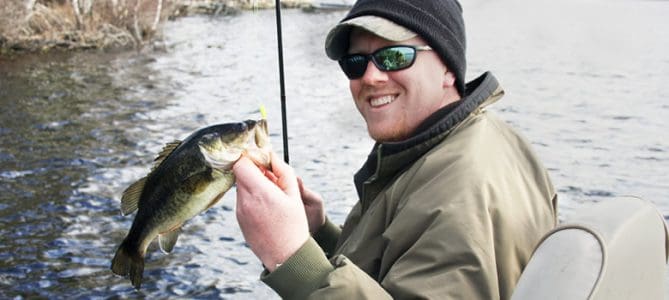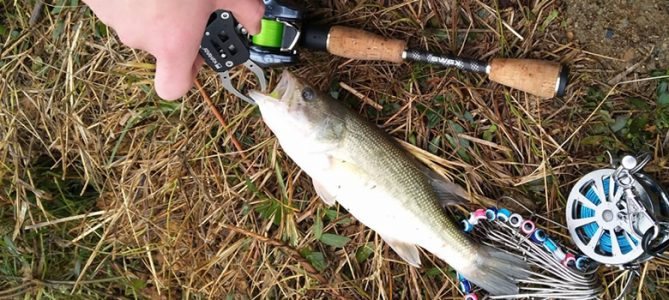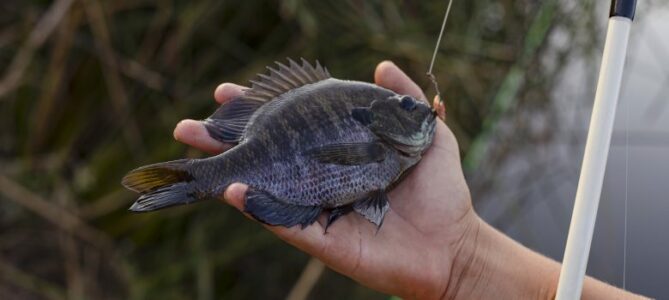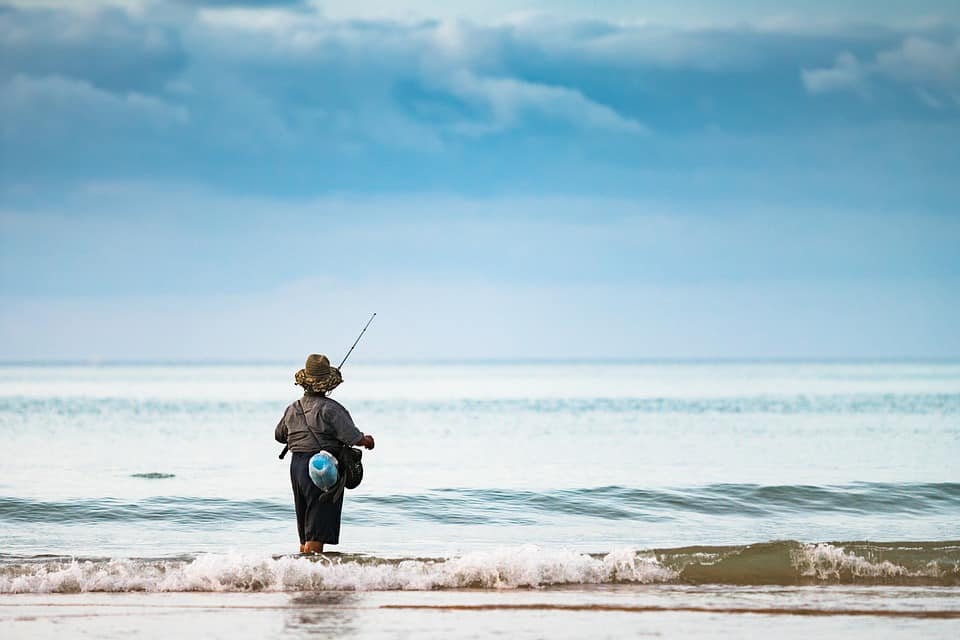If you buy via a link on this page, we may receive a commission, at no extra cost to you.Learn more
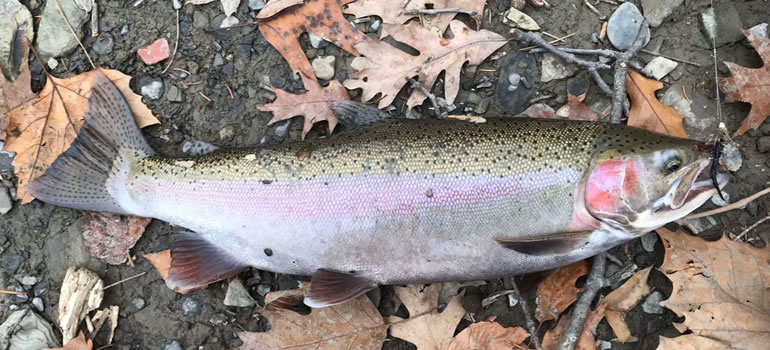
There are so many different types of habitats that rainbow trout inhabit, and numerous subspecies that all behave slightly differently from one another. Still, there are some general guidelines for fishing for the overall group of rainbow trout, no matter what shore you may be fishing from. For those of you that prefer to get your feet on the ground and off the boat, here are some key rules to stick to when fishing for rainbow trout from the lakeshore.
How do you catch rainbow trout in a lake from shore? The key things to keep in mind are:
- The time of year you are fishing in. Fishing in the winter season means that the fish will aggregate in the less frozen parts of the water column.
- Know whether you are fishing for natives or stockfish. This will directly influence the type of bait you will be using.
- Know the size of rainbow trout you’re aiming for. This will determine, again, the type of bait/lure you’re using in addition to the specs of the mainline and sinker.
The rainbow trout is one of the top five game fish in the United States, and, fortunately, is one of the easiest species to catch, despite the formidable fight it puts up against the angler. It is one of the most fulfilling experiences, to catch one of these trout from shore, so here are a few key guidelines on the best way to do so, in addition to the advantages of fishing from shore.
What You Need to Know About the Rainbow Trout
The rainbow trout, Oncorhynchus mykiss, is a popular game fish that thrives in fresh, brackish, and marine waters. This species of fish does very well in captive environments, meaning that they are strong reproducers in hatcheries and so have become a popular species to be released in lakes and streams all throughout the country.
Because of its prevalence in bodies of fresh water throughout the United States, it has risen into the top five sport fishes in North America and is even considered to be one of the most important game fish west of the Rocky Mountains. Although it is native only to the West coast, the rainbow trout has now been dispersed throughout almost the entire continental U.S., with the exception of a small portion of the Southeast.
The rainbow trout spawns in lake tributaries, and the young trout remain here to develop into adulthood when they migrate downstream. This migration takes place about one year after spawning. After taking between 2-4 years to mature in the lake, these fish return to the tributary to spawn – most often returning to the very tributary in which they hatched.
This species is world-renowned for the exciting experience it provides for anglers: when hooked, this fish puts up a formidable fight, often leaping out of the water for an awesome display of its last defenses. They’re considered less wary and easier to catch when compared to brown trout.
What is a Steelhead Trout?
The steelhead trout is the anadromous form of the rainbow trout. This means that the steelhead is simply a representation of the life stage of the rainbow trout in which it travels out to sea between hatching and returning to spawn. (So, instead of leaving a tributary to live its adulthood in a lake like some subspecies, this fish would spend its adult life in marine waters.)
Steelhead is prized even more than standard rainbow trout because they grow significantly larger and with more muscle than freshwater rainbow trout. They can grow up to 55 pounds and are 45 inches long! On average, though, they tend to weigh around seven pounds.
What Does a Rainbow Trout Look Like?
The rainbow trout is a carnivorous fish that extends about 20-30 inches long from tip to tail and weighs about eight pounds. (It is said that, although these are the average measurements, this fish can grow up to four feet long and weigh up to a whopping 53 pounds!) They are members of the salmon family and so resemble salmons in their appearance.
They have a torpedo-shaped body and are generally blue-green or yellow-green with a pink streak along the side. They have a white underbelly and small black spots on the back and fins. More specific patterns and colors in individual fish differ with habitat, age, and spawning condition.
General Techniques for Fishing for Rainbow Trout
The key when fishing for a specific species of fish is knowing that species’ ecology and behavior and how that will influence your technique. It’s impossible to set a highly accurate, general standard of fishing for a species like O. mykiss because there are so many subspecies, each with slight differences in behaviors and challenges to overcome in fishing.
Some of the best baits to use when fishing for trout are Powerbait and Eagle Claw Nitro Bait. This is because, when fishing specifically from shore, it’s important to realize that these fish have been farm-raised and stocked into the lake. This means that they are acclimated to foods that are not exactly natural, so baits manufactured with scents similar to aquaculture feed are your best bet.
To compose the floating rig, you’ll need to use a small egg sinker (1/4 to ½ ounce) and slip it onto the main fishing line. Tie a small barrel swivel without a snap attached (this will act as a “stopper” and prevent line twists) to the end of the line and use it with gang hooks or treble hooks. If using treble hooks, opt for size 12 or 18 and attach to a 12-18in. leader.
Here’s a rather basic set of additional guidelines provided by US Angler on fishing for rainbow trout, using the red band form as an example:
Colors of Your Baits and Lures
When you are fishing for rainbow trout on bright days (particularly if you’re fishing in clear water), it is essential that you use realistic colors for your baits and lures, considering their similarity in appearance to attract prey items. Whites, blacks, grays, silvers, and gold are all very good colors to choose from. The deeper you’re fishing, however, the more you will want to lean toward black and metallic flash or glitter.
In an additional consideration of the baits and lures, adding something bright, fluorescent, or flashy to your lure will increase the likelihood of it attracting the trout’s attention. A few strands of the bright skirt, sparkling glitter, or a flashing blade will surely attract your fish.
Vibration is an Important Addition to Your Lure
Something not many people recognize is that it is essential to have an element of vibration or movement on your lure. When using throwing lures or soft baits, bladed lure models like in-line spinners, or small, realistic crankbaits can resemble wounded prey in their movement. Of course, soft baits like worms, fluked minnows, and tube jigs work too.
Scented Baits
It’s also a good idea to add scented attractants and otherwise sweeten your lures to increase your chances of attracting a trout.
Some recommendations for scented baits specifically for trout fishing are floating mice tails, leeches, and floating fat trout worms.
Rainbow Trout Tackle
When fishing for rainbow trout, it’s best to use the lightest line you can reasonably use. This is important because trout have excellent eyesight, and if they detect a fishing line (it would be much easier to detect with a thicker line), there is a strong chance that they will not approach, especially in heavily pressured waters.
An ultra-light rod and reel would also be best when fishing for trout in still waters. However, if you will be facing a current, you’ll need to increase the action range of your fishing rod and reel.
Further, you’ll want to use a rod with a soft tip because a Rainbow trout will shake its head when caught. The soft tip will absorb the shock of the shaking without pulling the hook.
Why Catch Rainbow Trout from the Shore?
There are many advantages to fishing from shore versus fishing from a boat. First, the obvious is that not everyone who enjoys the sport of fishing has the luxury of owning or renting a boat. Fishing from shore is a great way for everyone who enjoys the sport to be involved and experience it regardless of financial status. Some may not prefer a boat, to begin with, so this is an option that works better for them as well.
Shore fishing also allows you to access spots that you potentially wouldn’t otherwise have been able to reach. On a boat, you’re restricted from coasting over rocky areas or having to worry about getting snagged on aquatic vegetation. From the shore, you can readily access the shallow and/or densely-vegetated waters that are usually teeming with fish.
Although shore fishing requires slightly more planning than boat fishing, you will need to scout out an optimal location along the shore where the fish are surely biting and where it is not already crowded with other fishermen.
Lastly, with the right technique, you are far less likely to risk frightening the fish with the noise and vibrations of your boat when fishing for trout from the shore. (Shadows, noises, and vibrations from a boat can scare fish up to a mile radius!) You can be a lot more inconspicuous, and therefore more successful, in your trout fishing from the shore.
How to Fish for Rainbow Trout from Shore
You should still adhere to the general guidelines of fishing for rainbow trout when fishing from the shore, yet you will end up putting a bit of a spin on your technique when adapting to fishing from shore. The core concepts to stick to when trout fishing, whether by boat or shore, are as follows:
- Know the area that you’re fishing in. Why? Because rainbow trout are native only to the West coast of the United States. If you are fishing further east than California, Iowa, and Wyoming, there’s a strong likelihood that the lake you are fishing in is stocked, meaning you will need to take into consideration that you are aiming to attract farm-raised fish. Scented lures would be best in this case.
- The most common lures for trout fishing are little “critters” that imitate large bugs such as grasshoppers, beetles, and crickets – or the bugs themselves, of course. (Do keep in mind, though, that larger trout – over one foot long – are less likely to be attracted to such a tiny snack.) Tubes, worms (or worm imitators), and swimbaits are awesome as well and are very effective attractants.
- Movement/vibration, color, and scent are all extremely important to the effectiveness of your lure. Knowing the prey items not only that the rainbow trout prefer but also those that are surely present in the lake will substantially increase your success in catching a trout.
Consider the Time of the Year
During the winter season, in some areas, you can count on a lake being frozen over. When this happens, lake trout will concentrate on the upper portion of the water column for feeding. (Ice fishermen have regularly hooked trophy specimens in as shallow as four feet of water!)
Later in Spring, when the ice begins to break up, lake trout will remain in the shallow waters for a few more weeks maximum. This is the best time for anglers who prefer fishing from the shore to get their angle on these fish without having to work too hard.
Additionally, because they are a bit more pressed for a meal during this environmental transition period, using bait such as salmon eggs is a surefire way to get some rainbows coming your way. Naturally, rainbow trout, among many other species of fish, scavenge spawning beds of salmon and virtually any other fish for this delicacy. Thread a few of these onto a size 6 hook and watch them go crazy!
Know Your Lake and the Trout that Live in It
As previously mentioned, rainbow trout is an extremely variable species, having a plethora of unique behaviors and preferences based on the locality and subspecies. Rainbow trout use all different types of water bodies, including cold headwaters, creeks, any size of rivers, cool lakes, estuaries, and the ocean. Knowing the area you’re fishing in, and perhaps even grabbing a map and/or speaking with a ranger will help you to know exactly where to look for your trout.
Regarding behavior as it relates to these water bodies: a reliable map that displays the contours of the lake will be priceless when you’re planning to do some shore-fishing. Trout tend to stick to the deeper waters, yet still close to the shallows. This is because they will swim into the shallows to snag a quick meal and return to the depth they’re more comfortable with.
Identify sites on the contour map where shallow waters are directly adjacent to deep drop-offs. Ideally, you’ll want to wade into the shallows that are situated directly next to these drop-offs, so that you can cast into the deep water and draw the fly or lure back into the shallows.
How to Set Up Your Rig for Rainbow Trout
You need to present a big meal in order to reliably attract rainbow trout. Get a 9- or 10-weight fly rod with an ultra-light to intermediate sinking line. Again, this will depend on where exactly you’re fishing and what weight of rainbow trout you’re expecting. Based on my earlier recommendation, you definitely need to consider the intelligence and eyesight of the rainbow trout.
Getting too thick of a fishing line will ultimately compromise your ability to be discreet with these animals. They’ll be able to spot the line from a mile away. However, if you are aiming not for the shallows but for these drop-offs, then you should consider using the heavier line.
On spinning gear, use 5- to 7-inch spoons or diving plugs: these are great for mimicking smaller trout, a favorite of the larger rainbow trout. If you’re looking to catch one of the big’s steelhead or the larger adults of rainbows, browns, and brookies, avoid fly, mayfly, and tiny-haired imitators.
Baits like these are not representative of the diets of the larger fish since they almost exclusively eat smaller fish, worms, shrimp, and larger insects. Small lures like the ones just mentioned will not be attractive to these bigger fish. Check the table below for key food items of rainbow trout.
| Food Items of Rainbow Trout | |
| Aquatic Food Items | Terrestrial Food Items |
| Dragonflies (specifically the larval and aquatic life stages) | Grasshoppers |
| Caddisflies | Ants |
| Worms | Beetles |
| Crayfish | |
| Plankton | |
| Snails | |
| Leeches | |
| Small fish | |
| Fish eggs |
Components for Setting Up Your Rig
Before setting anything up, go through this checklist to ensure that you’ve got all the right components for your rig.
- Make sure that the label on your Powerbait specifies that the bait is of the “floating” variety. Again, most anglers will be fine when fishing with Powerbait: given the range in which rainbow trout are native and not stocked in lakes and other water bodies, the likelihood is greater that you’ll end up fishing in a stocked lake where the fish are more acclimated to artificial foods and scents.
- This said, pack several different types of lures! Rainbow trout have varying tastes based on size, waterbody, season, etc. If one lure is not working well, it is wise to have brought along some extras in case the fish are not biting.
- You need an egg sinker, preferably ¼ to ½ oz.
- Barrel swivel
- Leader
- Mainline
- Rig
You can attach a whole red worm or half of a large nightcrawler on a small singular bait hook. It is recommended by How to Catch Any Fish to attach a sliding sinker to your rig instead of suspending the worm below a bobber. The worm should be positioned about 12 to 24 inches from the sinker. One of their tricks is to inject the worm with air from a syringe, so it floats off the bottom of the lake.
What this does is makes it significantly easier for the trout to spot the bait, and doesn’t require the fish to swim along the bottom of the lake and leave you with the hope of the off chance the fish will run into your lure.
Putting Your Rig Together for Rainbow Trout Shore Fishing
The following steps will help you in knowing how to put together a general trout fishing rig. Of course, the particulars of the setup are dependent on your preferences and the area you’ll be fishing in (for instance, the weight of the sinker, the length of the leader, and the type of bait will all be variable elements in the setting up of this rig).
Step 1. Take your mainline and slide on the egg sinker. The sinker will not only help you to reach the depth at which the trout are hanging out, but it will also help your bait to remain relatively still if you are fishing in an area with a relatively strong current (or any current at all).
Step 2. Take the swivel and tie the swivel onto the mainline using the knot of your choice. The swivel serves two purposes: It acts as a stopper for the egg sinker. Secondly, it serves as the connection between the mainline and the leader.
Step 3. Attach the leader to the opposite side of the swivel.
Step 4. Attach the hook to the end of the leader (the length of the leader depends on your preferences).
Step 5. Thread your bait of choice onto the hook, making sure that there is enough buoyancy to keep the bait from simply falling to the lake bottom. Make sure to leave the tip of the hook exposed so that you can get a good catch on the trout.
Additional Aspects to Consider When Setting Up Your Rainbow Trout Rig
It is essential that you plan ahead on whether you plan to eat the trout that you catch, or if you’re simply catching for sport and releasing the fish. Your plans will determine what type of hook you use. If you aim to simply catch and release, please be sure to avoid using hooks that will lodge deeply into the fish’s mouth or gills.
In this case, it would be best to use barbless hooks so that you can remove the hook easily after catching a fish.
Choosing the Best Site for Shore Fishing
When choosing your optimal spot for shore fishing, it is essential that you prioritize the elements of the fishing site that are going to have the greatest influence on your success in catching a trout:
- Check the crowd. You don’t want a site that’s too populated! Too many people in one spot can not only introduce the risk of you getting your line mixed up with the neighboring fisherman (this happens surprisingly often), but it can also reduce your chances of success due to any noise or excessive movement your fellow fisherman may create.
- This is especially important for situations in which you’ve had to wade into the water toward the drop-offs. Excessive movement from you or your neighboring fisherman will be readily picked up by the fish and alert them to your presence from potentially up to one mile away.
- Observe the status, movement, and temperature of the water. Of course, rainbow trout will always be found in cool waters – so checking the water for warm vs. cold is not exactly the goal here. What you should be focusing on, instead, is just how cold the water is.
- How to Catch Any Fish recommends the prioritization of slower-moving pools and small blips of moving water, often found behind large rocks or rocky outcroppings. The vital thing to keep in mind is that trout don’t sit at the parts of the water body where there is a current. Having to constantly fight against the current would tire them out.
- Remember, when you are considering wading into the water for fishing, you need to be aware of the clarity of the water. Once again, this is because these fish are incredibly smart. If they are able to recognize and avoid the fishing line, they are capable of recognizing and avoiding the shape and presence of a human being. If they are able to detect you far ahead of gaining awareness of your lure, they will be alarmed right away and you will have easily lost your opportunity at catching this magnificent fish.
Where Are the Biggest Rainbow Trouts?
Although they are native to this area, California is one of a few states that have large, genetically modified (artificial breeding is a form of genetic modification) trout. According to How to Catch Any Fish, Alaska has some of the largest rainbow trout in the world. Their guidelines on rainbow trout fishing recommend visiting the Kvichak and/or Naknek rivers, in particular.
These are some of the areas that are rumored to have some of the sites that are rumored to have massive rainbow trout, in addition to the River in Kamchatka.
Fishing from the Shore
Shore fishing is one of the most relaxing and fulfilling experiences an angler can have. Not only does it rid you of many of the inconveniences that come along with owning or renting a boat, but it also simply gets you closer – and even into – the waters, drawing a deeper connection with the waters and the fish you’re aiming for.
Give this guide a once-over again before you head out on your next fishing trip to make sure you’ve covered all your bases when aiming for a rainbow trout.

